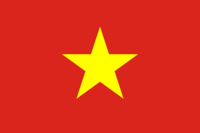Gia Long Tomb in Hue: A Unique Architectural Monument of the Nguyen Dynasty
The Gia Long Tomb is not only the final resting place of the founder of the Nguyen Dynasty but also a testament to the deep and enduring love between the king and his queen. Two adjacent stone tombs, standing the test of time, symbolize the bond that persisted both in life and beyond.
When traveling to Hue, history and culture enthusiasts will undoubtedly want to visit the final resting place of the first king who established the Nguyen Dynasty. The Gia Long Tomb in Hue, also known as the Thien Tho Tomb, not only boasts the most auspicious feng shui location among the tombs of the Nguyen kings but is also famous for the legendary love story between the Emperor and Queen Thua Thien Cao.

Where is the Gia Long Tomb Located? Directions to Thien Tho Tomb
The Gia Long Tomb, also known as the Thien Tho Tomb, was constructed over six years (1814-1820) and consists of multiple tombs within the royal precinct of King Gia Long. The tomb complex is situated in an untouched mountainous region, surrounded by picturesque landscapes, in Huong Long Commune, Huong Tra Town, Thua Thien Hue Province.
The entire complex encompasses 42 hills, both large and small, with the prominent Dai Thien Tho Mountain serving as the front part and seven other hills forming the rear part of the tomb.
In the past, the only means to reach the Gia Long Tomb was by water, taking a boat downstream along the Perfume River, passing by Thien Mu Pagoda, and the Hon Chen Temple. However, today, tourists have two options:
- Crossing a makeshift bridge constructed by local residents to the north of the Tả Trạch River.
- Taking the main road that passes through the Tuần Bridge, the Minh Mang Tomb, and the Hữu Trạch Bridge to the north of the river with the same name.

History of King Gia Long and the Enduring Love Story with Queen Thua Thien Cao
King Gia Long, born in 1762 with the given name Nguyễn Phúc Ánh (commonly known as Nguyễn Ánh), was the founder of the Nguyen Dynasty, the last dynasty in Vietnam’s feudal history. He ascended to the throne in 1802 and ruled the country until his passing in 1820. Despite being a formidable military leader, few are aware of King Gia Long’s deeply loyal and affectionate relationship with Queen Thua Thien Cao.
Queen Tống Thị Lan (Thua Thien Cao Queen) was the adopted daughter of Tống Phước Khuông, the External Guardian of the Tống Court. She was renowned not only for her beauty and gentleness but also for her dignified and respectful demeanor. She entered the royal court at the age of 18, becoming the Empress Consort, and stood by the king throughout the trials and tribulations of the era.
The unwavering love and commitment between the king and queen touched many, especially in light of the actions King Gia Long took after Queen Thua Thien Cao’s passing. In 1814, out of profound grief for the queen, the king decided to construct a tomb that mimicked the traditional burial practices of ancient times so that they could rest together in eternity.
During their lifetime, they shared months of hardships and beautiful moments, making their love story even more poignant. When Queen Thua Thien Cao passed away, King Gia Long wished to be with his beloved wife for the rest of his life, and beyond. This is why the Gia Long Tomb stands out as a uniquely designed tomb compared to others.

Exploring the Architecture of the Gia Long Tomb and Its Prominent Features
The Gia Long Tomb complex is divided into three main areas: the Tomb Area, Bi Dinh (Stele Pavilion), and Dien Minh Thanh (Minh Thanh Palace).
3.1. Tomb Area – Buu Thanh (Precious Wall)
At the heart of the complex are two adjacent tombs where King Gia Long and Queen Thua Thien Cao are buried side by side. These stone tombs, identical in size and separated by only a forearm’s width, are unadorned with carvings, gilding, or elaborate decorations, preserving their simplicity throughout the ages.
The remarkable feature of these tombs is that when viewed from behind, aligning with the ridge of the roofs of the two tombs, the Dai Thien Tho Mountain is perfectly centered, precisely “without any deviation.” This detail makes the Gia Long Tomb one of the most uniquely designed tombs in Vietnam, known for its exceptional feng shui.
Surrounding the tombs is a fortified wall called “Buu Thanh,” and the bronze gates of Buu Thanh serve as the entrance to the final resting place of the king and queen. The gates are opened only on special occasions, such as festivals and memorial days, for cleaning, maintenance, and renovations.
Below the gates are seven terraced courtyards, paved with Bat Trang ceramic tiles, adorned with stone statues of scholars, generals, elephants, and war horses, symbolizing protection and defense.
3.2. Bi Dinh – The Stele Pavilion Recording Merits
To the left of the tomb area is the Bi Dinh, a pavilion containing inscribed steles that record the merits and achievements of the Nguyen Dynasty kings. This structure is a common feature found in most of the Nguyen Dynasty royal tombs.
Inside the Bi Dinh, there is an inscribed stele titled “Thánh Đức thần công,” erected by King Minh Mang to honor his father (the first king of the Nguyen Dynasty). The stele features intricate decorative patterns and has remained legible for nearly 200 years.
3.3. Dien Minh Thanh – The Place of Worship for King and Queen
To the right of the tomb area is the Thien Tho Palace, centrally located on Bach Son (White Mountain) and surrounded by a fortified wall. This palace serves as the place for offerings, prayers, and veneration of the Emperor and Queen.
In the past, the interior of the Dien Minh Thanh Palace housed numerous relics associated with the tumultuous life of King Gia Long, such as hats, belts, and saddle saddles. However, due to the changing times, many of these artifacts are no longer present.
Apart from the Thien Tho Tomb, the Gia Long Tomb complex also contains the tombs of other members of the Nguyen royal family, including Thiên Thọ Hữu Tomb, Quang Hưng Tomb, Trường Phong Tomb, Vĩnh Mậu Tomb, Thoại Thánh Tomb, Hoàng Cô Tomb, and more.
3.4. Thiên Thọ Hữu Tomb and Dien Gia Thanh – Tomb and Ancestral Shrine of Queen Thua Thien Cao and Minh Mang
Within the Gia Long Tomb complex, the most notable structure is the Thiên Thọ Hữu Tomb and Dien Gia Thanh, the burial place and ancestral shrine of Queen Thua Thien Cao, the second wife of King Gia Long and the mother of King Minh Mang.
For marketing to international tourists, it’s essential to highlight the historical significance, architectural uniqueness, and the deeply romantic and enduring love story associated with the Gia Long Tomb in Hue. Visitors can immerse themselves in the rich cultural heritage and stunning landscapes while exploring this remarkable site.

